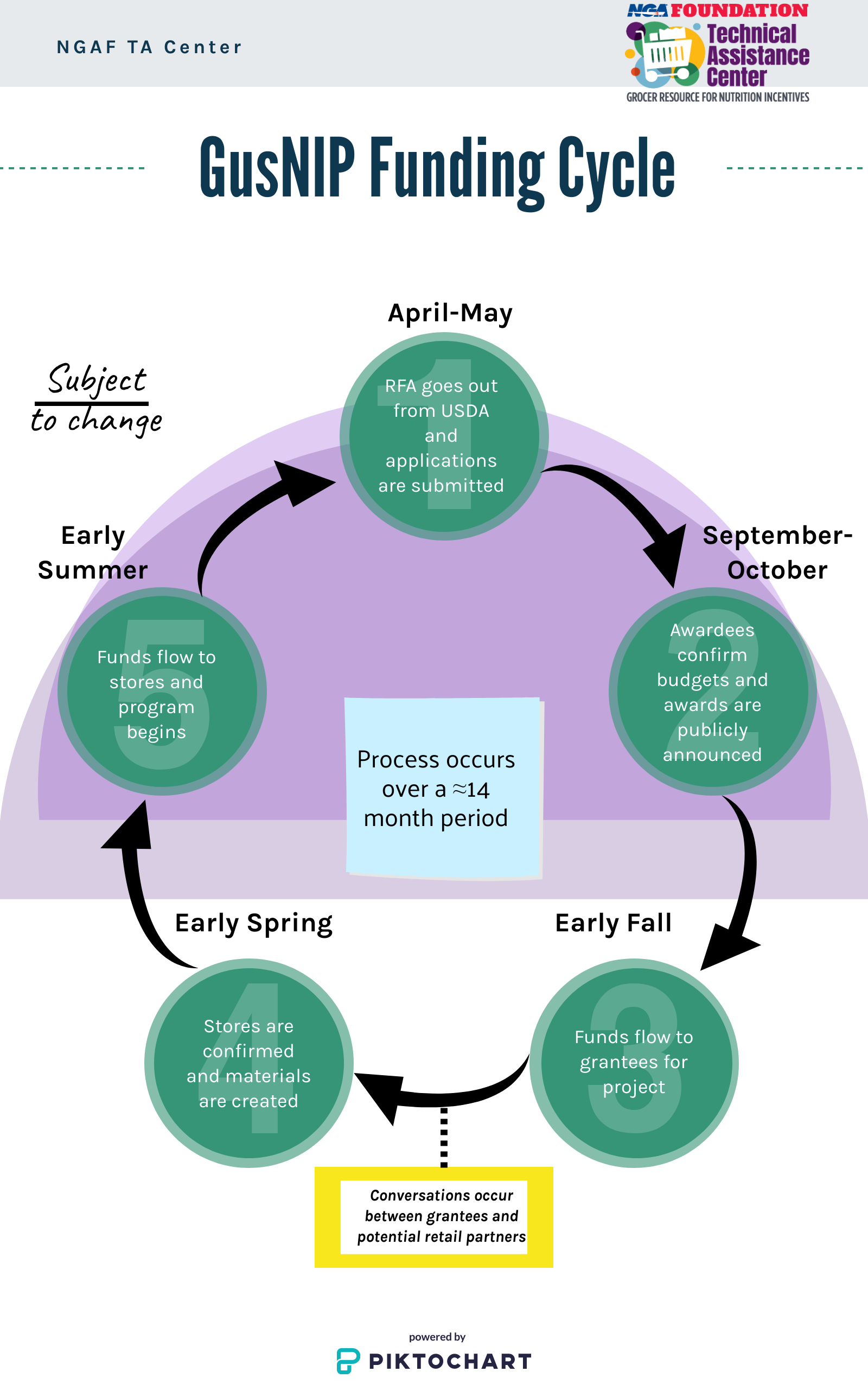By Patrick Jones, Project Assistant, National Grocers Association Technical Assistance Center
Retailers may have many questions about the Gus Schumacher Nutrition Incentive Program (GusNIP) grant process: When should I reach out to a local grantee about participating in a nutrition incentive program? How often do non-profits receive funding? What is their application process like? Is there any way I can proactively establish a relationship so that when they receive funding, they know of my interest?
In our time as the retailer Technical Assistance (TA) Center, we have received these and many other questions about how the GusNIP funding cycle works. For retailers interested in participating in a nutrition incentive program, it can be difficult to understand how the relationships between the USDA, a non-profit organization and the retailer themselves function.

In an effort to break the process down further, we have constructed a timeline of the funding cycle, described in detail below. These dates are subject to change during each application cycle, but this is the general order of the grant process.
Retailers typically begin the process with grantees at two different points. First, they could work with the grantee prior to an application and begin to build their relationship and program for anticipated funding. Alternatively, if a grantee does not have a retailer lined up to work with from their application, they will begin to seek out retailers post-award in the fall to early spring.
The timeline typically plays out as follows:
April-May: Request for application goes out from USDA and applications are submitted. Only non-profits and state agencies are eligible to apply, which is why a retailer must work with a grantee.
September-October: Awardees must confirm budget and budget narrative. Once finalized, USDA publicly announces recipients.
October: Fiscal year begins, and funds could begin at this point to flow to the grantee for implementation.
October– Early Spring: Conversations/outreach occurs between retailers and grantees to establish details of the program and ensure authorization.
Retailers must be authorized by USDA to participate, navigating these five steps with their grantee:
- Retailer obtains SNAP authorization
- Grantee and retailer execute a memorandum of understanding (MOU)
- Grantee submits MOU to SNAP Service Retailer Center
- Grantee submits retailer information to USDA FNS
- FNS approves or denies
This entire process can take up to 75 calendar days if the retailer is not SNAP authorized. If the retailer is SNAP authorized, it can take up to 30 days from the time of grantee submission of retailer information to receive notice of approval/denial.
New stores (once approved) begin a process to ensure everything is ready to go, the program design is properly executed, and to determine the amount awarded based on several metrics (e.g. SNAP percentage of sales, percentage of sales as produce, etc.). Once this process is complete, the grantee will funnel funds into their partnering stores.
Early Spring: All communications/signage are created for the launch of the program. The grantee typically provides marketing materials for stores (e.g., posters, flyers, rack cards). If retailers want to design their own materials, they should do so in collaboration with grantee.
Early Summer: Program launches, stores begin distributing incentives, and reporting/communication between grantee and retailer occurs on a (previously agreed upon) recurring basis (e.g., weekly, bi-weekly, monthly).
At the end of each year of the funding cycle, grantees and retailers assess the successes and shortcomings of the implementation and revise and/or continue their relationship for the following fiscal year. Depending on the size and scope of the grant, the longevity of the program itself may be variable. This aspect is ironed out in the application and confirmation stage between retailer, grantee and other participating entities.
As retailers can see, this process, while extremely valuable to SNAP customers and their communities, can take quite some time to be fully realized in the store, particularly at the stage of ironing out program details between October and early spring. This is why we recommend stores be “incentive ready” to reduce start-up time.
Some details of the grant process can vary from state to state, so if you would like to learn more about your state and the grantees potentially available to you, please reach out to our team at incentives@nationalgrocers.org.
The NGA TA Center addresses the challenges grocers and supermarket operators face in establishing nutrition incentive programs and is a proud partner of the Nutrition Incentive Hub. The Hub, funded through a cooperative agreement from the United States Department of Agriculture, National Institute of Food and Agriculture, is a new national resource that provides training, technical assistance, reporting, and evaluation for those working to launch or expand SNAP incentives or produce prescription programs. The Hub is led by Gretchen Swanson Center for Nutrition in partnership with Fair Food Network along with a coalition of evaluators, researchers, practitioners, and grocery and farmers market experts from across the country dedicated to strengthening and uniting the best thinking in the field to increase access to affordable, healthy food to those who need it most.
Thanks to Donna Martin of MARC (Mid-America Regional Council) for providing insight and guidance on this process.

